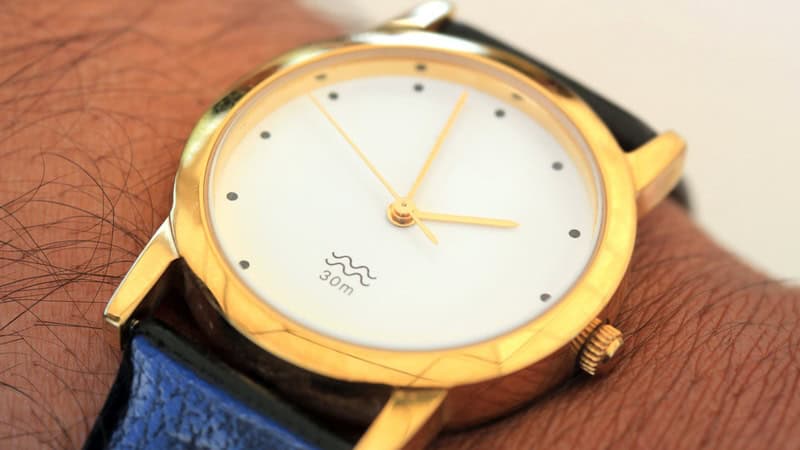Watch It!
Why the classic analog watch still has its fans

“There’s something deeply satisfying about taking a quick glance at your wrist and getting a physical picture of where you happen to be in any given 12-hour period,” writes Mike Spriegel. This is but one of many reason he’s still a fan of the classic analog watch.
Like most baby boomers, I grew up telling time on analog clock faces, and even though digital time readouts have been around for more than 50 years, I still translate those austere displays into the mental picture of a clock face. Call me old-fashioned, but I like physical representations of intangible things like time, and even tangible things like fuel levels, weight, etc. Just give me a dial with hands, needles, and hashmarks, and I’m a happy camper.
Which brings me to my most recent purchase: Here’s a hint, “It takes a licking and it keeps on ticking.” Yup, it’s a Timex … their best-selling, analog, quartz wristwatch, Expedition, to be exact. It set me back a pretty penny at $38.
It was either the Timex or the Rolex Submariner, but I opted for the one that didn’t lose up to a minute every 30 days. Yup, that’s right, a $38 Timex keeps better time than a $35,000 gold Rollie. That’s because – as precise as they are – mechanical watches can’t match the precision of a quartz crystal vibrating at a constant 32,768 Hz. And there’s no maintenance required for quartz – except for a new $6 battery every three years.
Rolex annual maintenance, on the other hand, can run close to a grand, and you’ll be without your timepiece for a while. Don’t get me wrong, they are both great watches, and they both end in “ex.” So, there’s that.
Old analog dog
My new Timex features the venerable clock face with hour, minute, and second hands. It has a little window that indicates the date but not the day of the week, which is OK with me because I can still remember what day it is without too much effort. The hands glow in the dark, and the INDIGLO feature lights up the dial with a cool, blue hue at the touch of the stem. Not only that, but it’s waterproof down to 50 meters – which is overkill for me since I rarely go below 35 meters on a typical day. It is an intricate collection of miniature electronics and tiny mechanical cogs and sprockets … a marvel of complex simplicity (an oxymoron, for sure).
Yes, there’s something deeply satisfying about taking a quick glance at your wrist and getting a physical picture of where you happen to be in any given 12-hour period. It’s like having a little live-action pie chart on your wrist that divides chunks of time into ever-changing slices that indicate how much pie you’ve eaten and how much you have left. No math required.
Heck, you don’t even need numbers on an analog watch … just little hash marks … or nothing at all, because anyone can tell the time just by the position of the hands on a blank face. The only better physical and visual representation of time is the hourglass, but hourglasses tend to be bulky, and having one strapped to your wrist is not a good look. Think Fred Flintstone.
Nope, you can’t do all that with digital stuff, and besides, those soulless little digits (especially the red ones) always remind me of the countdown display on bombs. Being an analog kind of guy, I prefer the old-fashioned movie and cartoon bombs that were attached to big, wind-up alarm clocks with enormous bells on them. Not only that, but digital watches have made terms like “quarter till” and “half past” quaint and obsolete. How sad.
The downside
The agony of watching an analog watch or clock is well known to schoolchildren and people who have to sit through interminable meetings. In these cases, the clock hands will actually freeze, and the remaining slice of the pie won’t get any smaller.
Clockwise
Here’s a fun fact: If sundials and clocks had been invented in the southern hemisphere instead of Europe, clocks would run reverse to what we call clockwise. That’s because the sun’s shadow on sundials in the northern hemisphere moves to the right around the dial. Below the equator, the shadow moves in the opposite direction, which would seem perfectly normal, and we would still call it “clockwise.” Neil DeGrasse Tyson explains this perfectly in one of his Star Talk episodes.
In conclusion
I welcome anyone who wants to dump their inaccurate Rollies, Cartiers, or Audemars Piguets to contact me at their earliest convenience. I will take them off your hands for under $75 each, and I’ll even throw in a Timex.
P.S. You know how soldiers and SWAT teams are always synchronizing their watches before a mission? This is because they are all wearing inaccurate high-end watches. If they had Timex’s, this wouldn’t be necessary.
Also, why do they call that contraption in factories and restaurants a “time clock?” Is there any other kind of clock? Kind of superfluous, if you ask me. Well, that’s all I have to say about that. Time for me to clock out.
Read more childhood memories and other contributions from Boomer readers in our From the Reader department.
Have your own childhood memories or other stories you’d like to share with our baby boomer audience? View our writers’ guidelines and e-mail our editor at Annie@BoomerMagazine.com with the subject line “‘From Our Readers’ inquiry.”



